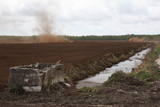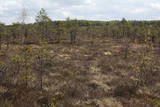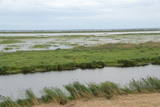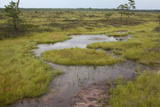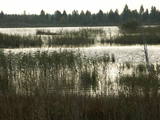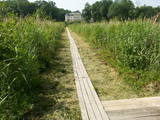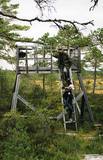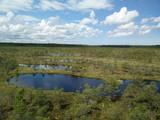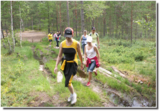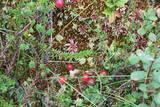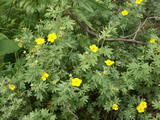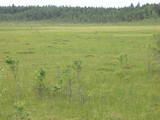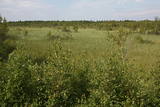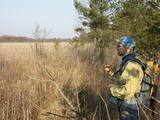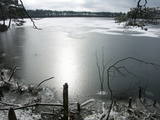| Nr | Nosaukums | Apraksts |
|---|---|---|
|
Lielākais Slīteres nacionālā parka purvs – stingrā režīma
zona, kurā apmeklējumi ir aizliegti.
|
||
|
Dabas liegums veidots ar mērķi aizsargāt dažādus mitrāju biotopus – t.sk. Lielo Ķirbas purvu un tajā esošās aizsargājamās augu sugas. Aizsardzība statuss ir piešķirts cilvēka mazietekmētajai purva rietumdaļai, taču pārējās purva platības tiek izmantota g.k. intensīvai kūdras ieguvei, bet neliela daļa – lielogu dzērveņu audzēšanai. Ķirbas purva dabas lieguma daļa nav labiekārtota un piemērota apmeklējumiem.
|
||
|
Teritorija veidota g.k. parastās purvmirtes un dažādu putnu sugu aizsardzībai. Kā interesants ir jāmin fakts, ka parastā purvmirte jeb balzamkārkls ietilpst Rīgas melnā balzama garšas buķetē. Brienamais purvs ir grūti atrodama un pieejama teritorija un kā tūrisma objekts apskatei nepiemērots.
|
||
|
Dabas liegums atrodas dienvidaustrumos no Lubāna ezera un tas veidots purva un meža biotopu un tajos esošo sugu aizsardzībai. Gar teritorijas ziemeļu robežu iet Nagļu - Degumnieku ceļš (iekļaujas kopējā Lubāna dambju sistēmā), pa kuru apkārt Lubāna ezeram izveidots velomaršruts. Tas nozīmē, ka teritoriju var aplūkot arī "no malas", netraucējot tās dabiskās norises. Teritorija ietilpst arī Lubāna mitrāja kompleksā.
|
||
|
Dabas lieguma mērogam – ļoti liela teritorija, kurā atrodas plaši mežu masīvi un vairāki purvi – daudzu putnu sugu nozīmīga dzīves vieta. Lieguma apmeklētājiem interesantākais objekts noteikti būs Vasenieku purva taka ar skatu torni, kas atklās ļoti savdabīgā purva ainavas gan no „purva līmeņa”, gan skatu torņa. Tiesa, lai veiktu pirmo pusotru kilometru, mitrā laikā noderēs ūdensnecaurlaidīgi apavi, jo takas virsma nav no koka, bet gan uzbērta kūdras vaļņa. Tālāk seko koka laipas. Informācijas stendi būs svarīgs informācijas avots un padomdevējs. Vērts apskatīt arī apdzīvotu vietu lieguma vidusdaļā – Stiklus, kur kādreiz bijusi stikla ražotne. Tajā veidotā lustra (pēc Ineses Rozes sniegtajām ziņām) vēl saglabājusies Stendes baznīcā. |
||
|
Kaut arī Sedas tīrelī jau no pagājušā gadsimta vidus iegūst kūdru, tā ir viena no Latvijas nozīmīgākajām NATURA 2000 teritorijām ar lielu ainavu, biotopu un bioloģisko, īpaši – putnu, daudzveidību. Potenciāla putnu vērošanas vieta migrāciju laikā. Šajā nolūkā purva malā izveidoti skatu torņi. Cauri purvam kvadrāta veidā stiepjas šaursliežu dzelzceļa uzbērums, kas kopā ar ritošo sasatāvu ir Latvijas industriālā mantojuma piemineklis. No tūrisma viedokļa interesanta ir ārpus lieguma teritorijas esošā Sedas pilsēta.
|
||
|
Vislabākais skats uz Vīķu purva dabas liegumu, kura centrā atrodas Lielauces ezers, paveras no skatu vietas pie Lielauces pils, kur sākas labiekārtota laipu taka, kas pa purvaino (pārejas tipa purvs) Lielauces ezera krastu aizved līdz laivu novietnei pie ezera atklātās daļas. Dienvidaustrumos no ezera izvietojies pats Vīķu purvs. Liegums veidots tajā esošo biotopu un sugu aizsardzībai. |
||
|
Salīdzinoši liela izmēra purvs austrumos no Zaļās kāpas. Tāpat kā Zaļais purvs – nozīmīga sērūdeņu veidošanās un izplūdes vieta. Purvu divās daļās sadala 3,5 km garais Ķemeru – Antiņciema ceļš, no kura paveras interesanta purva ainava. Minētais ceļš nav piemērots braukšanai ar automašīnu! Raganu purva austrumu daļā atrodas grūti pieejamais Putnezers. Savukārt Melnezera krastā, kas atrodas Ķemeru - Jaunķemeru ceļa malā, izveidots neliels auto stāvlaukums un uzstādīts informācijas stends. No šejienes līdz jūras krastam var nokļūt pa vēsturisko un nu jau aizaugošo Veco Ķemeru ceļu. |
||
|
Liegums veidots augstā tipa purva, purvaino mežu un retu putnu sugu aizsardzībai. Niedrāju – Pilkas purvu var šķērsot ar sausām kājām, vienlaikus baudot mazskarto dabu. To var īstenot gan pa bijušā Smiltenes – Valmieras – Ainažu šaursliežu dzelzceļa uzbērumu, kas 3 - 4 km garumā šķērso purvu DA – ZR virzienā, gan arī izstaigājot labiekārtoto lokveida laipu taku, kas atrodas uzbēruma austrumu pusē.
|
||
|
Viens no Latvijas lielākajiem (6192 ha) augstā tipa purviem ar ļoti izteiktām purva ezeriņu, lāmu un ciņu ainavām. Lielajam Ķemeru tīrelim ir ne tikai nozīmīga loma kā plašākas apkārtnes hidroloģiskā režīma un mikroklimata uzturētājam, bet tā ir arī putniem starptautiski nozīmīga vieta un viens no lielākajiem sērūdens veidošanās reģioniem. Purva austrumu malā - Kalnciema – Kūdras ceļa malā (3,4 km no Rīgas – Ventspils šosejas) uzstādīts informācijas stends, kas vēsta par Lielā Ķemeru tīreļa apsaimniekošanas pasākumiem un purvu lomu dabā un cilvēku dzīvē. 2013. gadā atklāta atjaunotā Ķemeru Purva taka ar koka laipām un skatu torni. Izveidotas 2 dažādu garumu riņķveida maršruti. |
||
|
Nacionālā parka mērogā – vidēja
lieluma purva masīvs, kurā savulaik iegūta kūdra
(kādreizējās izstrādes vietas šobrīd applūdušas).
Ziemeļos savienojas ar Čaukciema purvu. Atrodas
dienvidrietumos – rietumos no Zaļās kāpas.
|
||
|
Teritorija veidota augstā purva un tajā mītošo sugu aizsardzībai. Tas nav piemērots apmeklējumiem. Rietumos no purva stiepjas Nevejas – Lapmežciema ceļš, no kura bezlapu periodā nedaudz redzama purva ziemeļrietumu daļa. Tālāk – Cirstes virzienā aplūkojams viens no Latvijas iespaidīgākajiem dižozoliem – Rīgzemju ozols.
|
||
|
Purvs, kurā izplūst sērūdens avoti, izveidojies Abavas ielejas kreisā krasta nogāzes lejasdaļā. Tā ir vienīgā vieta, kur Latvijā savvaļā aug aizsargājama augu suga – krūmu čuža. Tās audzes aizņem aptuveni 1/5 daļu no lieguma teritorijas. Teritorijā ietilpst arī apkārtnes meži, dažādu tipu pļavas, Čužu sērūdeņu avoti, kā arī sēravots – „Velna acs”. Teritorijas apskates nolūkos ir izveidota un labiekārtota dabas izziņas taka. Dabas liegums atrodas Abavas senlejas dabas parka teritorijā (sk. sadaļu "Dabas parki"). |
||
|
Dabas liegums veidots salīdzinoši neliela pārejas tipa purva aizsardzībai. Purvu lieliski var pārredzēt no nelielā skatu torņa.
|
||
|
Teirumnīku purvs ir latvijas lielākā iekšzemes mitrāja - dabas lieguma "Lubāna mitrājs" sastāvdaļa, kas meklējams dienvidaustrumos no Lubāna ezera. |
||
|
Lai apskatītu purvu, tajā nav jābrien iekšā. Platenes purvu lieliski var pārlūkot no Ventspils Rīgas ceļa (starp 77. km stabiņu un autobusa pieturu „Pagrieziens uz Elkšķeni”), kur paveras tāls un plašs skats. Dabas lieguma nozīmīgākā aizsargājamā vērtība – kaļķains zāļu purvs ar rūsgano melnceri, kas ir šī biotopa lielāka atradne Latvijā. Uzmanīgi un valsts nozīmes autoceļa – apstājieties tikai atļautā vietā, netraucējot satiksmi! Dažus kilometrus Rīgas virzienā autoceļa malā uz Grīžu Velna krēslu, kas ir interesants dižakmens (aizsargājams).
|
||
|
Apmēram 3 x 3 km liela teritorija ziemeļos no Kūdras ciema, kur atrodas t.s. Vecie kūdras karjeri. Te pirmās Latvijas brīvvalsts laikā ieguva kūdru. Mūsdienās teritorija ir aizaugusi, saglabājot vecos un applūdušos karjerus, kas kopumā veido ļoti savdabīgu ainavu. Tos vislabāk var iepazīt, dodoties (ar kājām vai velosipēdu) no Kūdras dzelzceļa stacijas pa ceļu, kas ved līdz Slokas ezeram. |
||
|
Kaļķainais zāļu purvs izveidojies periodiski aplūstošā starpkāpu ieplakā, kas ir nozīmīga daudzu aizsargājamu augu sugu dzīvotne. Zāļu purvs ir dažviet pārskatāms no mežainajām kāpām, kas purvam pieguļ no dienvidaustrumu puses. |
||
|
Relatīvi grūti pieejama un cilvēka mazskarta teritorija kūdrā izstrādātajā Cenas tīreļa ziemeļaustrumu daļā, kur saglabājušies augstā purva biotopi ar purva ezeriem, kas kopumā veido nozīmīgu vietu ligzdojošām un migrējošām zosveidīgo, tārtiņveidīgo u.c. putnu sugām. Teritorija nav piemērota (un nav vēlams) tūrisma aktivitātēm.
|
||
|
Ziemeļos no Andrupenes lauku sētas muzeja dziļā starppauguru ieplakā ir iegūlis nelielais (130 m garš, 120 m plats) Andrupenes purvs – augstā tipa purvs ar klaju centrālo daļu. Ieplakas nogāzes klāj baltalkšņu audzes. Rāznas nacionālā parka administrācija 2009. gadā atjaunoja Andrupenes pamatskolas izveidoto purva mācību taku, izveidojot kāpnes, skatu platformu, dēļu laipas un informācijas stendus. |
||

